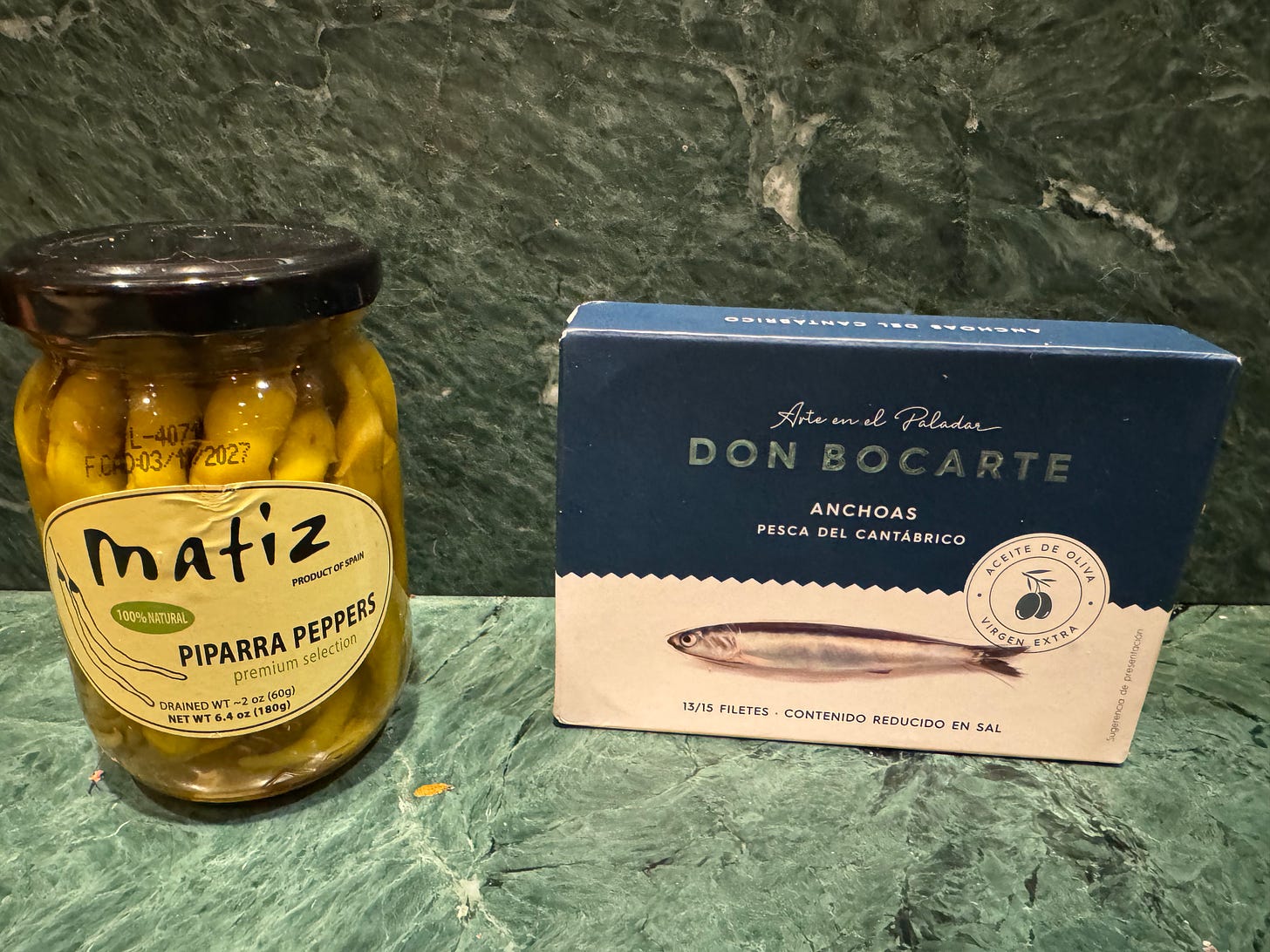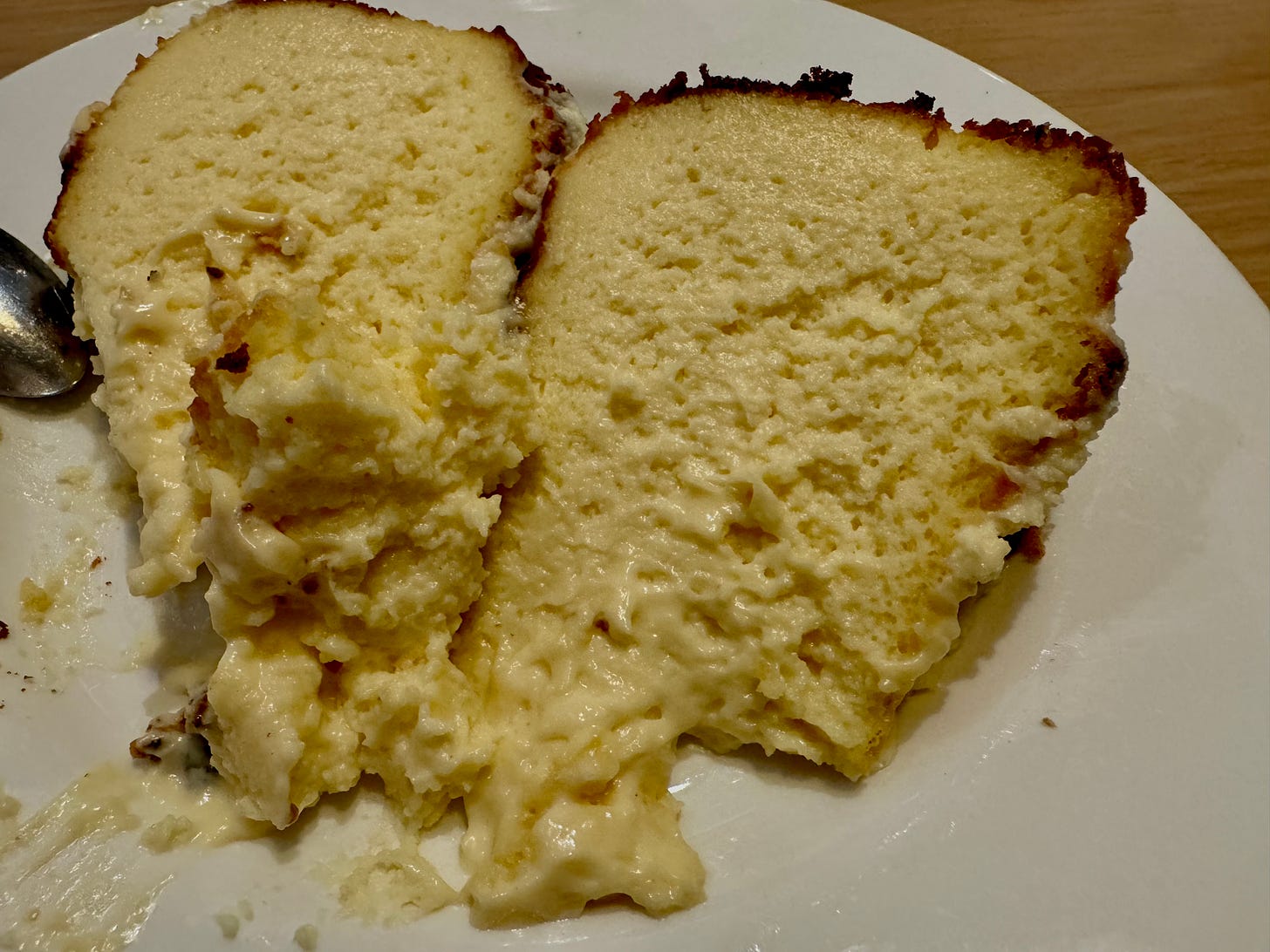A Few Inexpensive Gifts From Spain
Salt as you've never seen it, fantastic anchovies and the easiest impressive desert. Along with a most memorable meal.
This is definitely the year of the tapa. And one spectacular gift would be all the makings for the most classic tapa of San Sebastian, the Gilda.
All it takes to make a Gilda is Cantabrian anchovies, pitted manzanilla olives and piquillo peppers. You can buy these products many places like Despana and Donostia Foods. All you have to add are some toothpicks!
When I was in San Sebastian last month I became obsessed with the local sal de Anana, the flakiest salt I’ve ever seen (Maldon seems puny next to this). The salt enterprise, which has operated in the Valley of Anana since ancient times, has been recently resurrected.
I brought a few boxes back as gifts for friends, but now I’ve located a local source, MercadoCentral Any cook would be thrilled to receive this.
And while we’re on the subject of great Basque restaurants, I wrote about my trip to Spain a few weeks ago, and the spectacular meals I had at Asador Etxebarri and Arzak. But the other amazing meal I’ve had in that part of the world was a few years ago at El Kano.
This is Aitor Arregi of the restaurant Elkano in Gaitara, just outside San Sebastian. And that is one of the turbots for which he is justly famous. If you can eat only one fish in your life, this is the one you want. But only after Aitor has explained it to you, for he can find the entire world in a fish
If only I could capture Aitor's passion at the table, the way he talks about the turbot. “I don’t like the little ones," he will begin, "they need to be fat to get flavor.” He will go on to tell you that they are influenced by the temperature of the water, the time of the year, and mostly by what they eat.…
I want you see Aitor waving his eloquent hands to demonstrate how these flat fish swim. Turning the turbot he will show you the black skin on the bottom "the side that looks toward the sea," and then over again to display the white skin on top. "That side looks toward the sky." And yes, tasting carefully you do discern the difference, the slightly algal taste of the black side which has spent its entire life under water, compared to the more cosmopolitan white side, which has had the whole wide world to see.
Aitor will gently filet the fish, separating the left side from the right, pointing to his own body as he explains that the side with the organs - the liver, the heart - has a more complex flavor than the side that is pure flesh.
Pulling out the bones he will hand them to you, insisting you eat with your fingers, pulling the soft, slick flesh from the crunchy bones with your teeth.
Then he will take the larger bones at the head and crack them, exposing the marrow. "Taste it," he will urge, holding it out.
When you have finished you will not believe that a single fish can offer such variety. And you will never eat another fish without remembering this one.
Before the turbot you will eat cocochas - the tender flesh from the throat of the hake - which has the texture of the most perfect oyster you have ever eaten. He will offer them cooked in various ways, and you will love them all.
What else will you eat? Almost nothing. A bit of bread. Some of the restaurant's wonderful olive oil. And perhaps to end, their cheese ice cream with strawberry sauce.
Aitor will insist you drink the local txakoli, but from different years so you can taste the way it changes over time. You will drink another glass, and then another, thinking how lucky you are to be here in this wonderful restaurant.
And leaving, you will wonder how soon you can come back.
While we’re on the subject of Basque dishes, here is the easiest desert I know. When I want to cause a splash and have very little time, this is the recipe I go to. It’s so forgiving that while it calls for a springform pan, in a pinch I’ve been known to bake it in a Pyrex bowl. It is literally foolproof.
Burnt Basque Cheesecake
2 pounds cream cheese at room temperature
1 1/2 cups sugar
6 eggs
1 teaspoon vanilla
3 tablespoons flour
Preheat an oven to 400 degrees and put a baking sheet on the middle shelf.
Cut two long strips of parchment paper and fit them into a 10-inch springform pan so that it is completely lined and the edges of the parchment are higher than the pan. Don’t worry about creases - they won’t matter.
Put the cream cheese into a large food processor and process until very smooth. Add the sugar and process about 5 minutes more until you are sure there are no lumps. Add the eggs, one by one, beating after each addition. Add the vanilla. Sift the flour into the batter.
Pour into the prepared pan and put into the oven on top of the baking sheet. Cook for about 45 minutes until the top is almost burnt and the cake is set at the edges but still slightly jiggly in the center.
Remove from the oven and set on a cooling rack for a couple of hours. You can put it into the refrigerator where is will keep for a few days, but allow the cake to come to room temperature before serving.
(The picture above is the cheesecake at the source, La Vina in San Sebastian. As you can see, it is slightly underbaked. If you prefer this texture, take the cake out of the oven after about 30 minutes. If you like it more baked, you can leave it in the oven for up to an hour.)
And here’s a picture of the cake the time I let it get too burnt: I simply topped it with berries and nobody knew. As I said, pretty foolproof.


















I wish more Americans liked anchovies.
Hello Ruth,
Thank you so much for sharing my Gilda photo and mentioning Donostia Foods! The Gilda is at the heart of our entire product line, as Cantabrian anchovies, manzanilla olives, and guindilla peppers were the first products I offered, with hopes of evoking the joyousness of an evening wandering between pintxo bars of the Parte Vieja here in the States.
Your writing is tremendous, thank you for leading people to delicious food with such wonderful words!
All the best,
A.J. Weiss
Donostia Foods